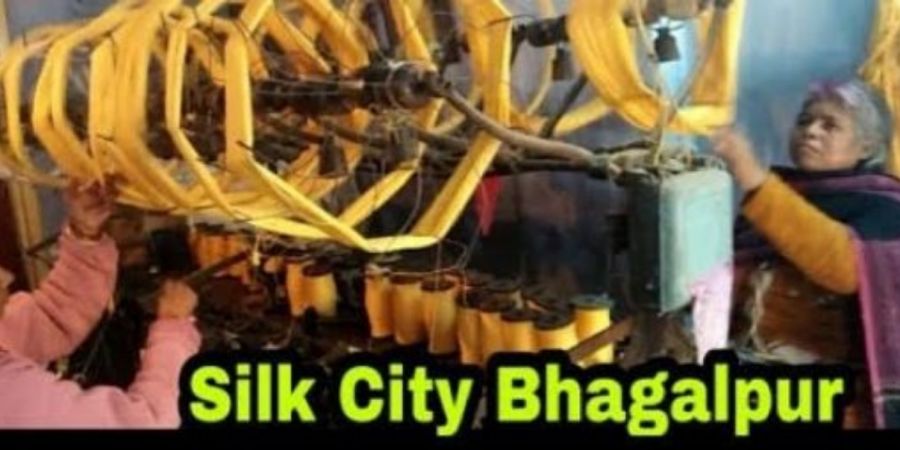

Today, Tasar silk is a costly fabric, prized mainly among the affluent class of people. This was not so in the pre-British days or even in the nineteenth century. Like muga and endi, tasar was considered to be a coarse variety of silk, popular among the local poor for its low price. Tasar was grown more extensively than muga and endi but South Bihar and the adjoining district of Bhagalpur, the production of tasar was negligible compared to that of mulberry silk. Tasar cocoons were reared on asan and sal trees in the forest tract of this region.
The insect tasar, was found in the forests of Bhagalpur. Santhal Parganas, Ranchu, hardaga, Palamau, Sighbhum, Midnapur, Bankura and Birbhum Generally, the tribes and caster engaged in this work were the Santhals, Kols, Paharias. Urauns. Cheros, Cherwarsa and some of the so-called low agricultural castes such as the Baglis, Rauris Bhaians Bhoglas, Samantas, Chamars and Kurmis. In the district of Birbhum in 1858 her silkworm was extensively collected in the forests of Sarhet-Deoghar and Kundhit Kuria by the tribals and semi-tribalas and exported to Bhagalpur The tribal people changed tasar cocoons for salt, cotton cloth, rice and other commodities Somurtumes as took cash advance from the Pykars or middlemen. Afterwards the collection was led and the advances were adjusted accordingly. These tribes combined this work along with other artisanal work such as basked making lac-growing and honey collec The producers had no direct contact with the market. Hence the production of sar cocnoms could increase only when the money lenders gave advance orders for increase supplies and provided the requiste advance.
The tasar rearing industry of Bihar and Bengal does not depend wholly on the indigenous loom industry of the province. There was some esport of tasar yarn. This occurred throuh the Giridih railway station to the United Provinces, chieffy to the town of Mubarakpur in the district of Azamgarh A considerable number of sacoons were exported to Sambalpur, Bilaspur and other districts of the central provinces. Approximately, half the produce of cocoons in South Ishar and Bengal districts was purchased by Louis, Payen and company and was reeled in to raw silk in their twe tasar factories in the district in Marshilabad. This raw silk was then exported to France.
Dalton observed in eighteen seventy two that the resters otrained money through the sale of en cons from which they paid their rents and fun in Mar, the reaners had to pay eight to twelve annas per season for the right to collect cocoons in bankura district, the right to collect was not forbidden by then everyone was at liberty to gather from the forest.'
In Bhagalpur, the rate was five annas per ehad." In the Santhal Parganas, the charge was levied either according to the number of treees farmed or twelve arnas to one rupee eight annas per patch of forest used as a feeding ground for the tasar silkwarm, and in Hazaribagh district, they paid to the Zamindar from six to eight annas for this privilege. "In Manbhum, the rearers paid an annual banker or forest rent to the land loard.
Tasar cocoons of Chota Nagpur were almost entirely esported to Bhagalpur. Gaya, Burdwan, Benaras, Azamgarh and Mirzapur, Chaibasa hat of Sighbhum, the largest cen tre for cocoon selling, was visited by weavers and mahajans from Bhagalpur. Patna Hazaribagh, Bankura, Burdwan, Murshidabad, Bilaspur, Sambalpur and the Southern Maratha country, all seeking their stock of cocoons.
Tasar silk was wound off in Bankura, Burdwan, Midnapur. Birbhum murshidabad, Bhagalpur and to a negligible extent, in the Santhal Parganas and Hazaribagh The cocoons from the Santal Parganas were exported to Birbhum and from Chota Nagpur to other reeling centres. In the large village of Tantipara in Birbhum dis trict "Several hundreds of Hindus are engaged in collecting and reeling off the tuner silk for the Calcutta market. The pykars, who had advanced money to the cocoon reaners, now puchased these cocoons and advanced them to the winders and also to the sesavers who reeled the silk employing family labout.
On account of tasar-reeling by Hunter in the Statistical Account of the Santal Parganas in eighteen fifty seven, it was stated that an average kanan of one, twelve eighty cocoons (that is five s yielded from one-one/two to seers of tasar silk.
There is no direct evidence on the quantity of tasar yarn exported to other provinces and to foreign countries and the quantity consumed by the weavers in the manitac turing districts. But we know that some European companies, like Louis. Payen and Company, were engaged in the business of tasar yarn export.
In the tasar weaving district of Bengal dhotis and saris were manufactured. From Bhagalpur district large quantities of course piece-goods were exported to the north western provinces and abroad."
In Bhagalpur Nathnagar, Sahjangi, Waris Aliganj and Champanagar were the chief centres of the tasar hand looms weaving industry. when dislocation in weav ing was already at an advanced state, it was reported that families of weavers were earning their livelihood by weaving tasar and bafta cloth. Such cloth, worth about five or six lakhs fo rupees was annually sent out of the district to different trade markets mostly in India, and to a smaller degree to France and Portugal. Bafta is mixed fabric, the wrap of which is tasar thread and the woof cotton thread. These bafta pieces were durable and prized by all classes of People"


